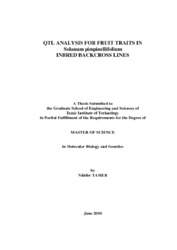Please use this identifier to cite or link to this item:
https://hdl.handle.net/11147/3797Full metadata record
| DC Field | Value | Language |
|---|---|---|
| dc.contributor.advisor | Frary, Anne | - |
| dc.contributor.author | Tamer, Nilüfer | - |
| dc.date.accessioned | 2014-07-22T13:52:23Z | - |
| dc.date.available | 2014-07-22T13:52:23Z | - |
| dc.date.issued | 2010 | - |
| dc.identifier.uri | http://hdl.handle.net/11147/3797 | - |
| dc.description | Thesis (Master)--Izmir Institute of Technology, Molecular Biology and Genetics, Izmir, 2010 | en_US |
| dc.description | Includes bibliographical references (leaves: 43-47) | en_US |
| dc.description | Text in English; Abstract: Turkish and English | en_US |
| dc.description | ix, 47 leaves | en_US |
| dc.description.abstract | Tomato is one of the most economically and nutritionally important crops. It contains antioxidants such as lycopene, phenolics, vitamins E, C, and .-carotene at high levels. These traits are of interest to consumers and plant breeders for their health-related contributions. The main aim of plant breeding is to improve agronomically relevant traits by combining characters from different parental lines or their relatives. Genetic markers reveal these characters and other genetic differences between organisms. In this study both health-related and agronomically important traits were phenotypically identified by using 120 BC2F7, BC2F8, and BC2F9 IBLs. Also the lines were genotypically identified using the BC2F10 IBL population. A total of 66 COSII and 11 COS markers were positioned on the IBL map. A total of 103 QTLs were identified. Of these QTLs, 25 loci were identified for antioxidant traits: total water soluble antioxidant capacity, vitamin C content, lycopene and phenolic content. In addition, 78 QTLs were identified for agronomic traits: fruit weight, fruit shape, fruit firmness, stem scar size, external and internal color, locule number, fruit wall size, and soluble solid content. For most of the antioxidant QTLs, alleles from the S. pimpinellifolium parent were favorable. This result indicates that S. pimpinellifolium can be used as a source of high nutritional traits in order to improve elite tomato lines. | en_US |
| dc.language.iso | en | en_US |
| dc.publisher | Izmir Institute of Technology | en_US |
| dc.rights | info:eu-repo/semantics/openAccess | en_US |
| dc.subject.lcsh | Plant molecular genetics | en |
| dc.subject.lcsh | Tomatoes--Genetic engineering | en |
| dc.subject.lcsh | Genetic markers | en |
| dc.title | Qtl Analysis for Fruit Traits in Solanum Pimpinellifolium Inbred Backcross Lines | en_US |
| dc.type | Master Thesis | en_US |
| dc.institutionauthor | Tamer, Nilüfer | - |
| dc.department | Thesis (Master)--İzmir Institute of Technology, Molecular Biology and Genetics | en_US |
| dc.relation.publicationcategory | Tez | en_US |
| dc.identifier.wosquality | N/A | - |
| dc.identifier.scopusquality | N/A | - |
| item.openairecristype | http://purl.org/coar/resource_type/c_18cf | - |
| item.openairetype | Master Thesis | - |
| item.languageiso639-1 | en | - |
| item.grantfulltext | open | - |
| item.fulltext | With Fulltext | - |
| item.cerifentitytype | Publications | - |
| Appears in Collections: | Master Degree / Yüksek Lisans Tezleri | |
Files in This Item:
| File | Description | Size | Format | |
|---|---|---|---|---|
| T000837.pdf | MasterThesis | 1.01 MB | Adobe PDF |  View/Open |
CORE Recommender
Page view(s)
228
checked on Jun 10, 2025
Download(s)
80
checked on Jun 10, 2025
Google ScholarTM
Check
Items in GCRIS Repository are protected by copyright, with all rights reserved, unless otherwise indicated.